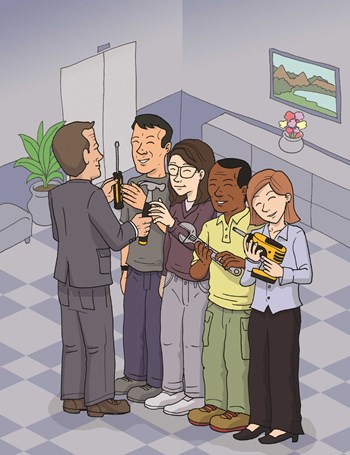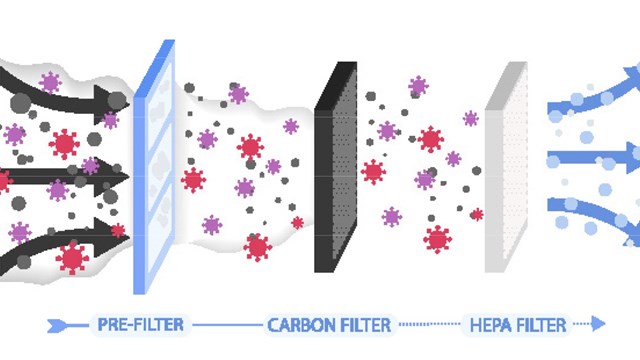
Say you’re in bed, and you hear what sounds like the shower going. It's late, and you're tired, so you pay it no mind. You wake up at 4 a.m. to get a glass of water and find half the rooms in your apartment flooded— you forgot to turn the shower off! You throw blankets and towels on the floor to soak up the water and call your building’s maintenance staff.
With the aid of a dehumidifying machine, they’re able to get most of the moisture out of the flooded areas. But the wooden floor tiles themselves are heavily damaged, and a fair amount of water seeped into your downstairs neighbor's unit, damaging the ceilings, walls and some artwork. Who’s responsible for restoring the flooring? And what about the water that poured into the apartment below?
The Basics
Finding out what systems and features in an owner's unit are his or her responsibility and which are the association’s responsibility can be a very complicated subject. Many principles are universal but other details can vary from building to building, depending on the rules of that particular community.
According to Lee Heller, a director of business management with Associa/Association Services of Florida, a management company in Miramar, owners are “typically responsible for the interior of their unit, the wall, ceiling and floor coverings. There's a hot water heater or an air handler, their appliances, the plumbing and electrical panel.” Unfortunately, this would likely include those wooden floor tiles, unless your building administration decides to be generous.
An exception, however, is piping inside the walls, says Ryan D. Poliakoff, senior counsel with Sachs Sax Caplan's Boca Raton law office. “Traditionally, pipes within walls and electrical elements that are within conduits within the walls are generally considered a common element, since they occupy interior space. Those things are usually the association's maintenance responsibility pursuant to the declaration.”
So, what else is the building or development responsible for? An association is responsible for whatever is considered part of the structures of the building, as well as common and limited common elements, says Tracey Schnaitman, the president of VIP Property Management Specialists, Inc. in Sunrise. This would include the hallways, lobby, elevators, basement, boilers or rooftop A/C, plus the electrical wiring from the point it enters the building from the street to the point it enters the circuit breaker or junction box.
It’s in the Docs
According to the professionals, leaks and window issues are the top two causes of conflict and confusion when it comes to issues of repair responsibilities. The most effective way to cut down on the uncertainty of repair liability—and hopefully prevent it from materializing in the first place—is for residents to know the rules in their building. And for their part, building administrators should make sure the rules are clear, concise, and unambiguous.
For owners, reading governing documents is key when it comes to understanding responsibility for repairs, Poliakoff emphasizes. “If you're going to own a condominium, become familiar with your governing documents,” he says. “They absolutely control everything that goes on in your property. They absolutely lay out your rights. They are contractual in nature and they are also covenants that run with the land, in the case of the declarations. And they are completely enforceable—except in very rare instances when a particular clause may be discriminatory or contrary to public policy. Most of the time, anything in a condominium document—particularly in a declaration—is going to be enforceable, no matter how weird it is. You must know your documents to know this issue,” Poliakoff says.
“Every set of condominium documents—or I should say in reviewing many, many, many, I've never seen one that didn't—will have two principal sections that are important,” Poliakoff explains. “One of those sections will outline what constitutes a common element or condominium property—usually common element because the association usually does not actually own property—and what portion constitutes what is within the boundaries of the unit and is owned by the unit owner.”
“The second section in every set of condominium documents will lay out the maintenance responsibilities for various elements in the building, whether they are common or limited common elements, which are common elements which are dedicated to the use of one or more people specifically to the exclusion of others, or owned property portions of the unit,” Poliakoff says.
The experts say that 99 percent of Florida associations have this specific repair information listed in their documents. “Usually, this was already done by the developer and their attorneys who prepared the governing documents in advance of the initial sales offering,” Schnaitman says. “Rarely would the declaration of a condo or co-op be amended to change a level of responsibility of this nature.”
So, while it might be rare for a board to have the need to amend an association's documents with repair and maintenance responsibilities clauses and clarifications, it can be done if need be. If a board does find the need go this route, its attorney should carefully review these documents to make sure they conform with the building’s current or desired practices.
Gray Areas
As in nearly everything, there are some gray areas when it comes to who's obligated to fix what in a multifamily building.
“Sometimes, documents are drafted without thinking of the consequences of how they're describing things,” Poliakoff says. “For example, a condominium declaration could say that 'all windows are the responsibility of the unit owner.' Well, what about the window frame? When they say 'window,' does that mean the frame too? Does that just mean the glass in the window? Disputes like that come up all the time.”
Other places at the intersection of the wall and a specific piece of equipment are a frequent source of conflict, such as plumbing risers and valves (like the one under the sink that turns the water off, for instance), air conditioning equipment and air conditioning sleeves within the walls.
“I will tell you another place where you see distinctions which can sometimes cause disputes are when you're talking about pipes particularly,” says Poliakoff. “Sometimes a declaration will say that a pipe that only services a single unit is the maintenance responsibility of that unit owner, even though that pipe is inside a wall. But a pipe that services the entire building—a sewage drain pipe, say—is the association's responsibility. We do see distinctions like that all the time in condominium declarations,” he says.
Poliakoff goes on to say that it is not uncommon for legal counsel and/or mediators to step in to resolve issues involving repair responsibility.
“I know of a case that dealt with an open question of who was responsible for repairing a window in a condominium,” he says. “And in order to repair this particular window, it would have been required to actually do a drop of a swing stage or a scaffold off of the side of the building. And the arbitrator in that case basically said...it is not reasonable to interpret this document to assume that the unit owner would have borne the responsibility for something that requires dropping a scaffold over the side of the building. So sometimes these disputes have to be resolved by arbitrators or courts. But a lot of times, frankly, as counsel for associations, we just simply get angry letters—particularly from people who are used to living in rental units and think everything within that unit, like in a rental apartment—is the responsibility of the building, when that's not the case,” he says.
Alterations are yet another potentially sticky area—though perhaps a little less so than some of the others mentioned above, since most communities have the rules and regulations regarding alterations spelled out explicitly in their governing documents. In general, if you do an alteration, you are responsible for it, the professionals say.
Importance of Insurance
Documents aside, requiring homeowners’ insurance policies of all shareholders or unit owners is one way management can be sure that gaps can be closed and conflicts avoided, Heller says. Such a policy can cover not only personal items such as computers and furniture, but also paint, wallpaper and flooring.
Adequate insurance coverage also plays an important role in the intersection of maintenance and repair responsibility, Heller says. He illustrates this point by asking readers to visualize a Venn diagram.
“One circle is ownership—who owns the item, one is maintenance responsibility, and one is insurance responsibility,” Heller says. “With well-written documents or smart documents, they're all the same. But unfortunately, many times they are not the same. So, like in Florida, statute comes in and says that by law, the association is responsible for the insurance on the air-conditioning system from the roof to the air handler. So in the casualty event—a storm or a fire or whatever—the claim would go through the insurance from the association, and they pay the premium for that.”
“However,” he continues, “that immediately makes owners think the association is responsible to maintain the air-conditioning system, which it's not. So when it breaks, or it isn't serviced regularly, those problems come up and those are the unit owner's absolute responsibilities. On the third circle, let's say the unit owner owns the air handler in their unit and the air-conditioning compressor on the roof. They own that equipment, but that unit up on the roof is in a common area that's not necessarily available to unit owners. So, that sometimes creates a problem as well.”
According to Poliakoff, determining whether an event is insurable can be quite confusing and complicated, but the answers to what claims qualify can be found in subsection 11 of Florida Statute Chapter 718 (called the Condominium Act) and in, you guessed it, in the governing documents.
“The Condominium Act talks about insurance, defines separate repair and replacement responsibilities that govern in the case of hazards,” he says. “To determine whose maintenance responsibility it is, you go by what's in the governing documents. But if it is a hazard, for example, let's say a pipe bursts and floods out four floors of units, you then look to the Condominium Act to determine who is responsible for what repair and replacement. Section 718.111, sub. 11, states that 'every property insurance policy issued after 2009 must provide primary coverage for all portions of the property as originally installed or replacement of lifetime in quality, and all alterations or additions made to a condominium property or association property pursuant to another provision. Coverage must exclude all personal property within the unit, or limited common elements and the floor, wall and ceiling coverings, meaning paint, and wood and tile, electrical fixtures, lighting fixtures, appliances, water gears, water filters, built in cabinets, visited window treatments...any portion of the condominium property that must be insured by the association gets property loss...damage by an insurable event shall be reconstructed, repaired or replaced as necessary by the association as a common expense’,” Poliakoff explains.
Oftentimes, it’s not easy to determine responsibility for repair elements. Most of the time, whether you’re talking about condos, co-ops or townhomes and when owners take good care of their units, problems won’t occur. For those times when they do, be sure to consult your attorney and building manager and look to your governing documents for answers.
Raanan Geberer is a freelance writer and a frequent contributor to The South Florida Cooperator. Editorial Assistant Enjolie Esteve contributed to this article.






3 Comments
Leave a Comment